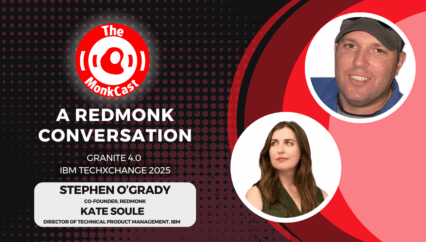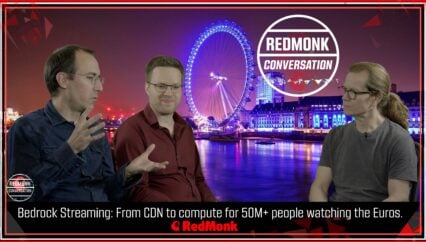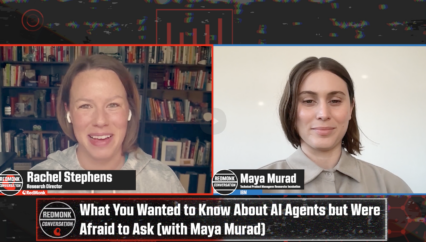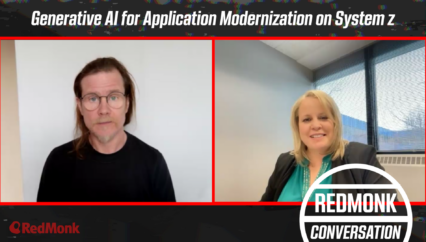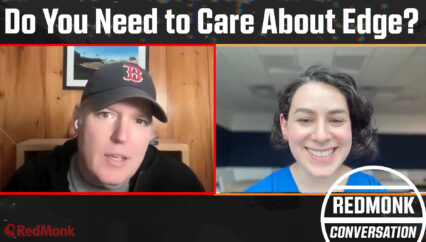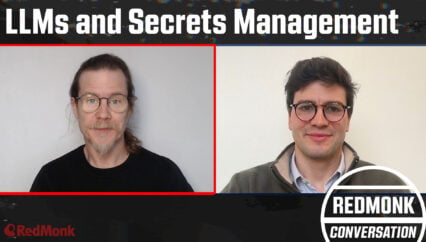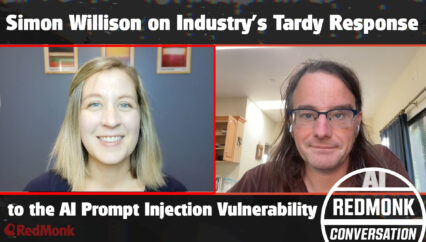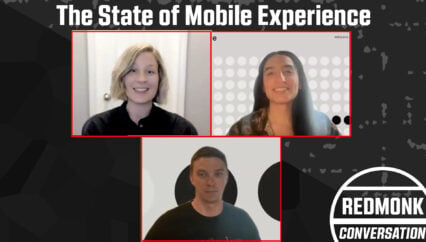James Governor from RedMonk and Sanjay Sarathy from Cloudinary discuss the company’s strategy for developer engagement, focusing on YouTube as a key channel. Cloudinary, founded by three developers, has grown to 2 million users and aims for 5 million. It targets specific ecosystems like JavaScript (Next, Nuxt, Vue, React,) sponsoring third party developers to create engaging, educational content. These efforts have driven registrations up beyond 45,000 monthly. We also discuss Cloudinary’s business model and plans for global growth.
Transcript
James Governor 0:04
Hey, it’s James from Redmonk, and we are here for another RedMonk conversation. And what we’re going to be talking about is, well, kind of three things, really, community engagement, the use of video in that, and particularly YouTube. We’re going to be talking about API driven businesses, developer experience and the great idea of product led growth. Today with me, I have Sanjay Sarathy from Cloudinary, and yeah, we had a conversation recently that was sort of, well, it was online, but offline, it wasn’t recorded, and I thought we really should record it, because I thought it’s really interesting things that Cloudinary is doing, and also some of the things about Cloudinary scale that were worth taking account of capturing and sharing. So on that note, Sanjay, why don’t you tell me what it is you do at Cloudinary and why we should be interested in cloudinary as a company and what you’re doing.
Sanjay Sarathy 0:54
Thanks, James, great to be here on the show. I’ve been at Cloudinary about seven years, and I wear two hats in my current role. The first is I’m responsible for developer engagement, where we work on behalf of the developer community. We engage with developers around the world, and in that regard, I manage a team of developer relations, documentation folks and people like that. The second hat I wear is the responsibility for a self service business, and which makes up today between 25 and 30% of our revenues. And the two are very closely related, because developers are our primary audience and often the first folks who invest in Cloudinary, whether in self-service and oftentimes, are the drivers for a lot of our enterprise deals as well.
James Governor 1:46
Okay, and so, yeah, tell me a bit about this, this. Well, I think one of the things I’m really interested in is, obviously, from a community engagement perspective, we ask ourselves, you know, what we should be investing in? And obviously there are a number of channels that we could invest in. Tell me a bit about your journey to realizing that YouTube in particular was going to be a great channel. No pun intended for cloud and area in terms of driving developer engagement.
Speaker 1 2:18
Sure. So Cloudinary was founded by three developers, and so their ethos was, how, how can we build a company that focused on people like ourselves, right? How would we want to engage with a company like Cloudinary? And so the focus was very much around creating content, creating code, creating samples that would allow developers to understand the power of our image and video platform, and we did this through early days of a variety of channels. We had our own blog channel on our website. We participated in hackathons, we spoke at conferences. They’re all the usual, nothing hugely surprising, but I think one of the things that we’ve noticed over the years is sort of the secular trend towards YouTube as an incredible search engine in and of itself, okay? And two, I think how developers like to learn by finding other developers who are building in public and showing how you can build in very specific ecosystems that map to their interests, and we started to get inbound interest from people that said, yeah, be great if you could show how, show us how to do XYZ, and it wasn’t one of those things where they were going to come to our site and read a blog post. They wanted something that was a little more interactive and a little more engaging, so they could see the code being built in real time, right? And we started to experiment, really. We started to do this a few years ago with videos on our own channel. And we started to talk about, you know, one of the, one of the areas, what we call dev hints, these very short two to three minute how tos that focused on how to build XYZ in Astro with, you know, with a variety of other ecosystem tools, yep. And what we found is that tended to, you know, guage interest. And we said, oh, this is really interesting. How can we scale this? Because we realized while we’re confident and proud of what we’ve done, our channel is not necessarily the largest channel at the time in in the industry. So we started to partner with other developers who had YouTube communities of their own, and they started to showcase applications built with Cloudinary and Hano and database x and we and. Sometimes these tutorials would be long. There’d be two hours or three hours, but they would be really engaging, because developers would be very excited about saying, Great, I built this incredible photo editing app using AI from scratch. I can clone this because we they would point to the GitHub repo, and I can do this on my own.
James Governor 5:21
Okay, quick question, when you say partner with so were you, you were paying these third parties, or…
Speaker 1 5:26
Yeah we were sponsoring. We were sponsoring these developers, to build these apps, and it was very transparent, because the YouTube video would say, this is a paid sponsorship post. So we weren’t trying to hide that at all, but we were trying to do it in the context of making it educational, yep, so showing you how to, how to create something of use, rather than just talking about features and capabilities.
James Governor 5:53
Right, right, right. And did you like, sort of say, identify, I mean, you mentioned Astro. Was it like, Okay, we should identify people in particular frameworks. You know, here is an expert in Vite or, like, what was your approach to deciding, or was it just, this is a developer with a lot of followers on YouTube, and therefore we should ask them whether they’ll do it. What was the thinking? How did it work?
Speaker 1 6:14
Yeah, no. We focused on specific ecosystems. So we we started. We picked one well, JavaScript as the broad based front end framework, but more specifically things around Next, Nuxt, Vue, React, and those were the primary front end frameworks and libraries that we picked on the JavaScript side, and we picked Python on the back end, on the server side. So those were we deliberately picked. Even though we have SDKs with Java and C# and a variety of mobile frameworks, we couldn’t be you know, we had started to see significant traction within our own SDKs in terms of adoption, and we wanted to sort of double down on those and create even more visibility. And so that’s we deliberately picked specific ecosystems and found people in those ecosystems that were comfortable in building educational style content and were and wanted to do this sort of thing. And it’s awesome.
James Governor 7:19
I got to tell you. I mean, one thing is, it’s hard enough to get people to watch a five minute YouTube video. The two hour video is that, you know, that’s got to be some pretty a pretty engaging developer, right there.
Speaker 1 7:31
Exactly – it was interesting talking with the team, because I asked the same question. I said, is anybody going to watch anything more than five minutes, 10 minutes and and I think what we what we learned is if, if the conversation is around how to do X, and it’s in steps, and you don’t have to do everything at once, and you can come back and you show the code in real time, and you give people access to the GitHub repo, so even if they don’t watch the full video, They can clone it and start working playing on their own, and come back to see the steps that can be quite engaging and and really, the bottom line is, when we went back and surveyed the people this summer about how they first heard about cloudinary James. You know, you know, across these 45,000 registrations we get every month now, basically, YouTube wasn’t, was either number one or number two in terms of how they first heard about cloud variant. And so, you know, we think of it as as an investment that we want to continue to make as a way to, you know, we’re not a big enough organization. We’re 400 people to be in every single relevant hackathon or conference. That makes sense for the communities we work with. But we do believe that as a means to reach developers initially and then give them the opportunity to explore cloudinary Further, YouTube is has been absolutely fabulous for us.
James Governor 9:03
Yes, well, I mean, if it’s driving 45,000 sign ups a month, that’s, those are good numbers. Those are happy numbers, right there, yep, yep, and so and tell me about total so, I mean, you know your your user base is, and maybe that’s changed. But, I mean, I remember you talking about the fact that you hit 2 million developers. Do you feel, you know, that’s grown? Where are we now in terms of the size of your community and how you’re estimating that?
Sanjay Sarathy 9:34
Yeah, so we grew. We hit the 2 million mark at the beginning of the summer, I think we announced that publicly, and you know, a good deed never goes unpunished. Our CEO now, sort of comes to us and says – great! – you know, how quickly can you hit 5 million, right? So, so, and I think it isn’t just about the numbers, even though we’re metrics driven, it’s about, what does that mean, right? What types of. Developers are we engaging with? I think our early engagement with developers, oftentimes they were fairly experienced, fairly senior. You didn’t have to put a lot in front of them. You could give them the SDKs. As we expand the pool of developers we work with, oftentimes they don’t have as much experience. We need to be better at at showcasing the the initial experience, making it easy for them. So it’s it’s not just about sort of discoverability at scale, which is a mantra at cloudinary that we talk about. It’s also ensuring that the experience across all these different types of developers is simpler over time. So that’s so it’s a two pronged approach for us. One is one is scale. How do we reach the 5 million number? The second is about making it even easier to engage with the platform once you register. And that’s a big part of the investment that we’re making on the product side as well. Okay,
James Governor 11:04
and so that 5 million number I heard you what? So What? What? When is that like you? When will the punishment beatings happen?
Sanjay Sarathy 11:15
The punishment beatings happen in a few years. It’s a big lift. You know, we hit the first million. You know, this is funny. We hit the first million after nine years, the second million after in the in nine years, the second million after three years. So, of course, people are just assuming, you know, the same logarithmic scale. So great a year and a half to hit 4 million, right? Sanjay, I’m like, yeah, nice try. And so there’s a bit of give and take, but I think the more important part is, where do you know which communities of developers make sense for image and video platform? We believe strongly that images and videos are really the experiences of both today and the future, and make it easy for people to incorporate images and videos into their apps. And is is going to be a secular trend, and that’s something we’re seeing. Whether you’re an individual developer working on your blog, on your personal blog, yep, or you’re a fortune 50 company looking to, you know, to scale billions of dollars of E commerce revenue through through the experiences delivered through those images and videos.
James Governor 12:29
Tell me a bit about that. So do you in terms of the model? So, like individual developers can, can, can just use the platform, you know, like credit card, okay, I’m using cloud. No. Now, what does the conversion look like in terms of, you know, and you put your revenue hat on here. So it’s one thing for a developer to be interested. But then, what about when an enterprise is making a strategic commitment to the platform? How does that is there a handoff there? Or how do you go from one to the other? Or how does that work from a business model perspective?
Sanjay Sarathy 12:59
Yeah, so the way self service works is we have a free product, you can basically use it, and it’s capacity driven, consumption driven, and then we have a series of steps self service plans that start at $99 and go up from there based on what your consumption needs are. And basically there’s a top tier that is roughly, I think, 1100, bucks a month. And you can do a lot of work in with images and videos, even on that tier. What then starts to happen is, as enterprises say, hey, we want, you know, Platinum support, or we need these specific capabilities, or we want a dedicated Success Manager, and these specific capabilities, oftentimes those conversations then start occurring with the support organization. And I think one of the things that occurs from our perspective is that we will support everybody from free all the way to people on a platinum support plan, right? And it’s one of, I think the keys to Cloudinary success is we, we invested in that support and CS organization from the very get go, right? And so we’re able to showcase, even in that early period, how you can use the platform to your success. And then what starts to happen? One trend is commercial companies say, Hey, we’re growing, and we need a a higher level plan, because we’re just beyond the capacity that your self service plans can can support us with. And if you look at our enterprise customers, we have 10,000 paying self service customers today, right? Okay, if you look at our enterprise customer base, actually, we have about 95 9400 9500 we’ve got 700 800 or so enterprise customers. And what I would say is, you know, a significant percentage of them came. I originally signed up as self service customers, right? And so they started paying us 99 to $49 a month, and now they’re paying us six figures a month. And so, so there is a handoff there. There is another way in which people will start playing with the product, almost use the free product as sort of a quick POC, and then contact us through the website, going great, I’m XYZ from company ABC. Would love to chat with you about an enterprise plan. And in those situations, those go directly to the Salesforce. They don’t go through the typical sort of step by step process. And then the third sort of mechanism, from a enterprise perspective, is sort of our own enterprise sales motion through a number of different means, where we’re engaging with people through events and conferences and outbound SDR work and and driving visibility that way as well.
James Governor 16:04
So one question me talking about developer experience, you’re going out there you are, you know, partnering with and sponsoring folks in, you know, framework communities. How do you, I guess, the question is, how do you do you close the loop? Like, I mean, you’re in terms of developer experience, we’ve been talking about a little bit more of the outbound activity. But like, how do you listen and capture, you know, requirements, or is that part of developer experience in your Yeah, so how do you bring stuff back to the product team and be like, Okay, this is what we’ve learned. We excited a bunch of developers now they want X How do you How does that work?
Sanjay Sarathy 16:50
Yeah, it’s a great question, and absolutely the way we think about it is both outbound and inbound. I’ll give you a concrete example of what’s happening right now. So we talked about ecosystems and frameworks. We’re very focused on, on the Java JavaScript ecosystem. And one of the things we’ve done very recently is we’ve received a bunch of feedback around developers experience with our SDKs, right and what they’re doing. And so what has happened is our team has created a requirements document around, hey, the next generation of the front end SDKs around what changes we think we should make, and we actually are in the midst of defining what should happen to v3 of our SDKs with the R and D and product management teams, right? So we, we find ourselves bringing those requirements or writing them out, right? And there’s a long document that we’ve created around us bringing it and bringing first hand. And then there’s a lively debate around, you know, what should we do? You know, what aspects should we incorporate, etc. But we absolutely find ourselves at the vanguard of bringing some of those requirements in based on our own experiences as well as our the developers who work with our platform in as well. And it’s not just we who are doing it. We get those the R and product management teams, get that through the customer success team, through the support team, through a variety of channels. We are obviously one of, one of the major channels of bringing that input back as well. Okay,
James Governor 18:32
awesome. So I guess you know final question, then you’ve got this big target, this audacious goal, like, what do you think are going to be the key investments and strategies for you over this next couple of years, as you try and hit those goals, you know, more investment in YouTube. What would that look like? Are there new platforms that you’re beginning to identify? What do you think you need to do to, you know, to hit those, those audacious goals?
Sanjay Sarathy 19:00
Yeah. So if you think about the strategy for sort of developer engagement, I think there’s, you know, we think of it in sort of three, three buckets. One of one of the buckets is around ecosystems. What ecosystems are we going to continue to invest in? We’ve, for example, in addition to, say, Python on the server side and JavaScript on on the client side. You know, we’ve put a lot of investment into our mobile SDKs, right? And one of the one of the areas we’re focused on is what types of applications and use cases can really take advantage of our mobile SDKs, and how can we get developers engaged through that? So ecosystems is one bucket. The second is this notion of geographies, right? I mentioned at the outset that we have been lucky enough to be a global company from the get go. And so how do we think about potentially localization of content? Right, using content, not. Just in English, but localization in languages that are relevant to developers in those communities. So, for example, I think before we came online, one of my team members sent me a YouTube sort of sample in Hindi in India, which is again enormous, enormous population of developers, great credibility, but you can’t always speak to, you know, you can’t always put out content just in English. And so I think this notion of how we speak to a global audience in a localized fashion, yet having very global principles around the APIs that we have is is an interesting investment area for us, and how we think about it, yeah, yeah. That makes and, and then the third one is around segments. And the way we think about what I mean by segments is we’ve today everybody, whether you’re a student a SMB, an enterprise, can all register for cloudner In the same way, but one of the investment areas is maybe we should segment it so that we think about our commercial segment. People who we know will pay for cloudinary At some point in time. Yeah, say students, and the idea is they’ll never pay for cloudinary in the short term, but we still want them to be successful with their projects. But how you interact with them, and how you engage with them is a very different is very different than how you would engage with, say, a commercial, an SMB, or even an enterprise who’s who’s registered for your product. Okay, that all makes sense. Those three, those three areas, are sort of how we’re thinking about I mean,
James Governor 21:46
I just think that we’re going to be seeing a lot of cloudinary content and a lot of different languages. I mean, think about the geos – Indonesia, Vietnam. I can imagine a lot of Brazilian content is on the cards. Portuguese, yes, yeah, absolutely. You’ll need, need some of that. I mean, you know, I think a lot of the, I mean, I think a lot of the African developers seem to be doing a lot of content in English, but that’s a whole set of opportunities for you. Nigeria is a huge developer market, but we’re seeing activity in in Ghana, North Africa, you know, Morocco has a thriving developer community. Yeah, love all that. I’m always excited by the the growing, the globalization of developer communities. That’s fascinating and interesting place to stop and but from your perspective, a great way to think about, where are you going to find those, those next few million developers, because, yeah, they’re not all going to be in North America or in Europe. So that’s, that’s exciting. Absolutely, yeah, I don’t, I don’t think that we are entertaining enough that we’ll keep people watching for two hours. So I think we’ll, we’ll, we’ll cap it for today, but, but you know, hopefully have you on the show again, Sanjay, I think this has actually been really fascinating for me, a lot of really interesting insights. So thanks very much for joining me.
Sanjay Sarathy 23:13
Thanks a lot, James. Really glad to be here and really appreciate all the questions. Cheers.
James Governor 23:17
And obviously, as Sanjay said, if you, if you’ve got any image handling needs, get on over to cloudinary and, you know, check it out. And if you’ve got any comments on that on board onboarding experience, I’d love to hear it. Hear from you. So anyway, that’s a redrunk conversation. Thank you all very much. You
Transcribed by https://otter.ai

